A Waxing Moon in Evening, Planets Appear after Sunset and Midnight, Minor Planets Dance with Deep Sky Delights, and Nova News!
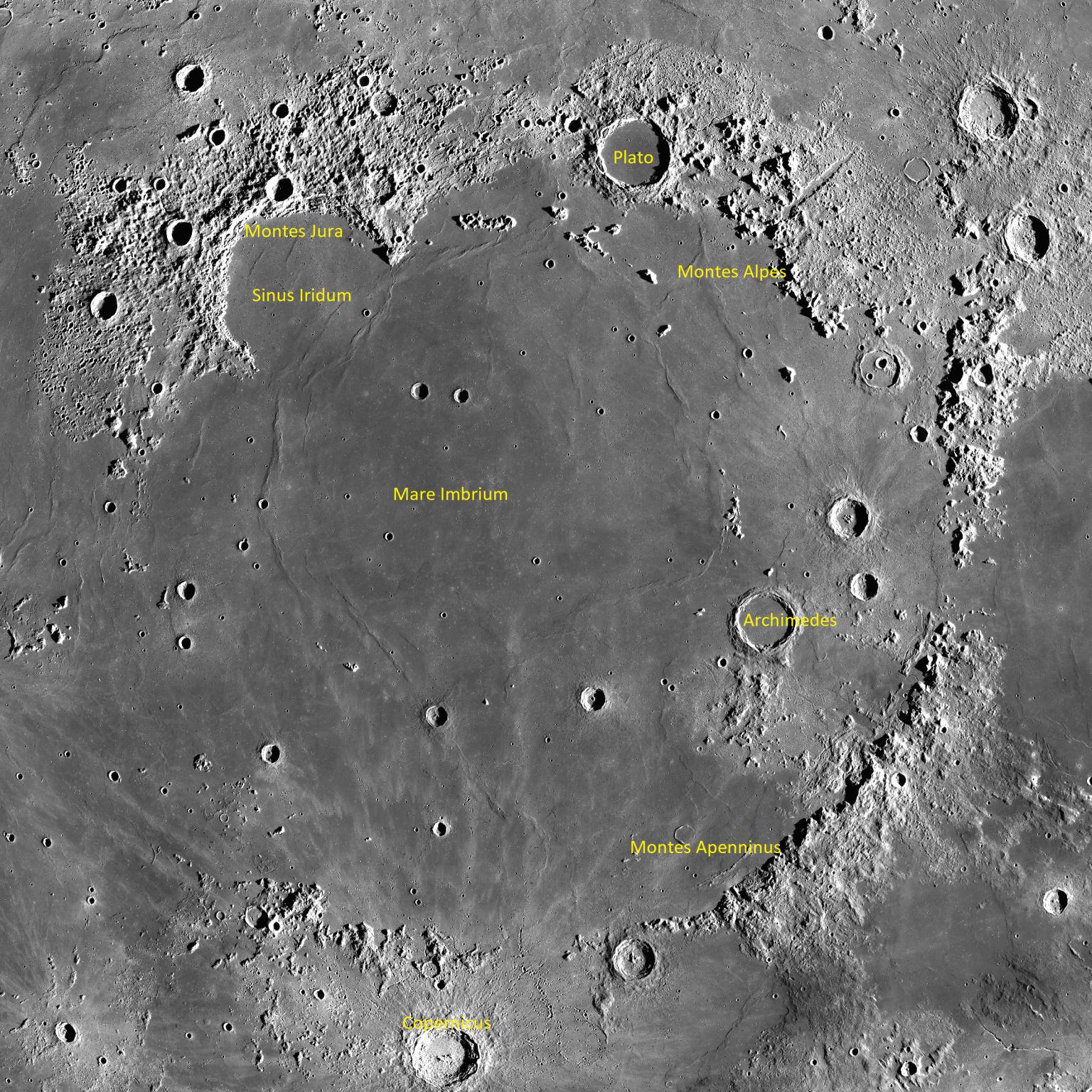
This mosaic of images taken by the Lunar Reconnaissance Orbiter is centred on Mare Imbrium, the huge and ancient impact basin that covers much of the moon’s northern Earth-facing hemisphere. The mountains around its right (lunar west) edge are highlighted around the first quarter phase. Sinus Iridium and the curved Montes Jura are prominent about two days past first quarter. Wikipedia and NASA
Hello, mid-June Stargazers!
Here are your Astronomy Skylights for the week of June 13th, 2021 by Chris Vaughan. Feel free to pass this along to your friends and send me your comments, questions, and suggested topics. You can also follow me on Twitter as @astrogeoguy! Unless otherwise noted, all times are expressed in Eastern Time. To subscribe to these emails please click this MailChimp link.
I can bring my Digital Starlab portable inflatable planetarium to your school or other daytime or evening event, or teach a session online. Contact me through AstroGeo.ca, and we’ll tour the Universe, or the Earth’s interior, together!
This week, the moon will be shining in the evening sky all around the world. Evenings will also host dim Mars and brilliant Venus, minor planets passing deep sky objects, a small comet near bright Arcturus, and a new star in Aquila! The gas giant planets will rise at about midnight and then remain visible until dawn. Read on for your Skylights!
The Moon
This is the week of the lunar month when our celestial sibling will be shining in the evening sky – perfect for viewing the lunar terrain when it is dramatically lit by low-angled sunlight – with unaided eyes, binoculars, or any sized telescope.
Tonight (Sunday) the crescent moon will shine prettily above the reddish dot of Mars in the west-northwestern sky after sunset – with very bright Venus shining less than two fist diameters to their lower right (or 17 degrees to the celestial west). As soon as the sky fully darkens, use your binoculars to find the large clump of stars known as the Beehive Cluster and Messier 44. It will be centred a few finger widths to the left of the moon. (I have more news about the Beehive below.)
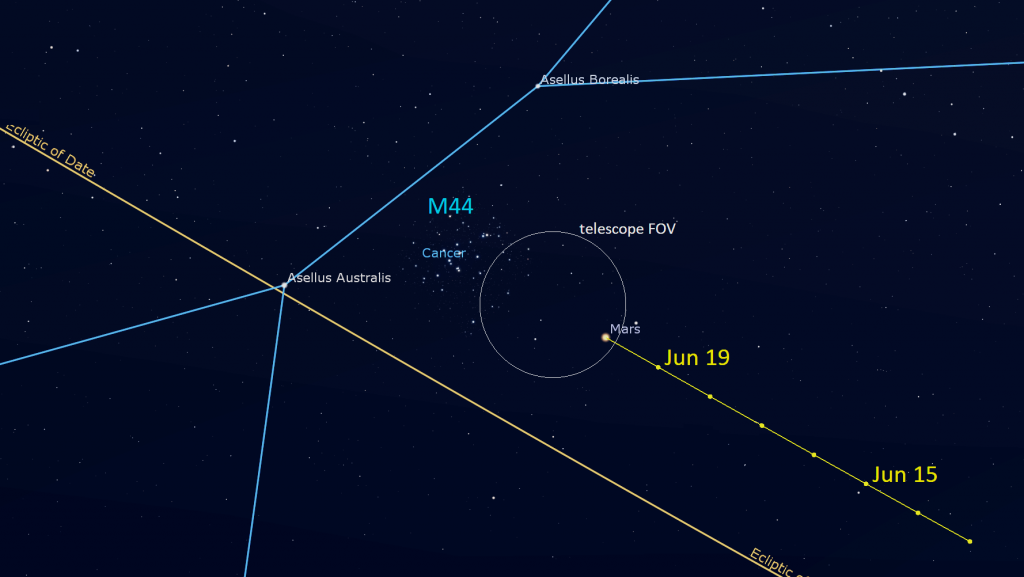
Each night this week the moon will set later, and its illuminated phase will grow, because the moon will be increasing its angle from the sun. On Tuesday night, the moon will land among the stars that form the backwards question mark shape of Leo (the Lion). The kingly beast’s brightest star, Regulus will be situated a short distance below the moon. The moon will spend Wednesday night under the lion’s belly.
The moon will complete the first quarter of its orbit around Earth at 11:54 pm EDT on Thursday, June 17 (or 3:54 Greenwich Mean Time on June 18). That night everyone on Earth will see the moon looking half-illuminated – on its eastern side – amidst the stars of Virgo (the Maiden). At first quarter, the moon always rises around mid-day and sets around midnight, so it is also visible in the afternoon daytime sky.
On Friday night, the now gibbous moon will pass just above the medium-bright star Porrima in Virgo. That star, named for the Roman goddess of prophecy, splits into a nice double star when viewed in a backyard telescope. Try it! On Saturday night, the bright moon will hop east to sit several finger widths above Virgo’s brightest star Spica, or Azimech. The star’s name means “ear of wheat”. Its Chinese name is 角宿一, Jiǎo Xiù yī, the “First Star of the Horn”. The spectacular Alps Mountains and Apennine Mountains that encircle large, dark Mare Imbrium will look spectacular on Friday, too.
Finally, on next Sunday night, the 81%-illuminated moon will enter the constellation of Libra (the Scales). That night will be perfect for viewing the Golden Handle effect, produced when the terminator falls to the left (or lunar west) of Sinus Iridum, the Bay of Rainbows. Slanted sunlight brightens the eastern (right-hand) side of the prominent, curved Montes Jura, the mountain range that surrounds the bay on the top and left (north and west). You can see the feature with sharp eyes – and easily in binoculars and backyard telescopes – even before the sun sets.
The Planets
This week, brilliant Venus will continue shining over the west-northwestern horizon after sunset. This week the planet will be setting at about 10:30 pm local time. That time stays about the same each night because Venus’ eastward orbital motion is counter-acting the westward motion of the sky produced by Earth’s orbit of the sun.
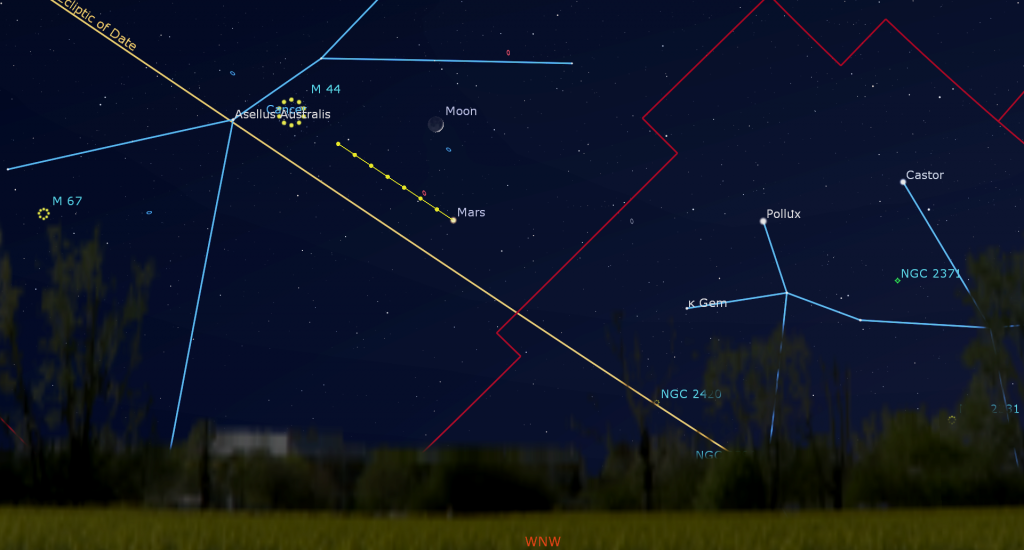
Venus’ bright dot should pop out of the darkening sky, a little to the left of where the sun went down, at about 9:30 pm local time. The planet’s position on the far side of the sun from Earth will make it look a bit less than fully illuminated in a telescope. For the best view, look at Venus in your telescope as soon as you can see the planet. That way, it’ll be higher, and shining through less distorting atmosphere.
You can use the crescent moon to find Mars tonight (Sunday), but the Red Planet will remain in view all week – long after the moon has sped away from it.
As the sky is darkening (after about 10 pm local time) look about 1.5 fist diameters above the west-northwestern horizon for a reddish dot sitting to the left (or celestial southeast) of the similarly-bright stars Castor and Pollux, the twins of Gemini. Mars will set in the west at around 11:30 pm local time. Mars’ eastward orbital motion will lift it a little higher than Castor and Pollux from one night to the next. That motion is carrying Mars directly towards the Beehive Cluster. By next Sunday night, Mars will be close enough to the cluster for the planet and the cluster’s stars to share the eyepiece view through a telescope at low magnification. Next week, Mars will pass directly through the bees!
Saturn has now officially entered the evening sky – and Jupiter will soon join her! This week yellow-tinted, magnitude 0.55 Saturn will rise within the stars of central Capricornus (the Sea-Goat) just before midnight local time. A few weeks ago Saturn began a retrograde loop that will last until mid-October. You can observe the planet’s westerly motion by noting how its distance from the medium-bright star to its left (east) named Theta Capricorni increases each night. If you get up early, or stay up late, to see them, watch for the Milky Way and the teapot-shaped stars of Sagittarius (the Archer) sitting several fist diameters off to their right (celestial west).
Even a small telescope will show Saturn’s rings and several of its brighter moons – especially its largest moon, Titan! Because Saturn’s axis of rotation is tipped about 27° from vertical (a bit more than Earth’s axis), we can see the top surface of its rings, and its moons can arrange themselves above, below, or to either side of the planet. During this week, Titan will migrate counter-clockwise around Saturn, moving from the upper right (celestial west) of Saturn on Sunday night to the lower left (east) of the planet next Sunday. (Remember that your telescope will flip the view around.)
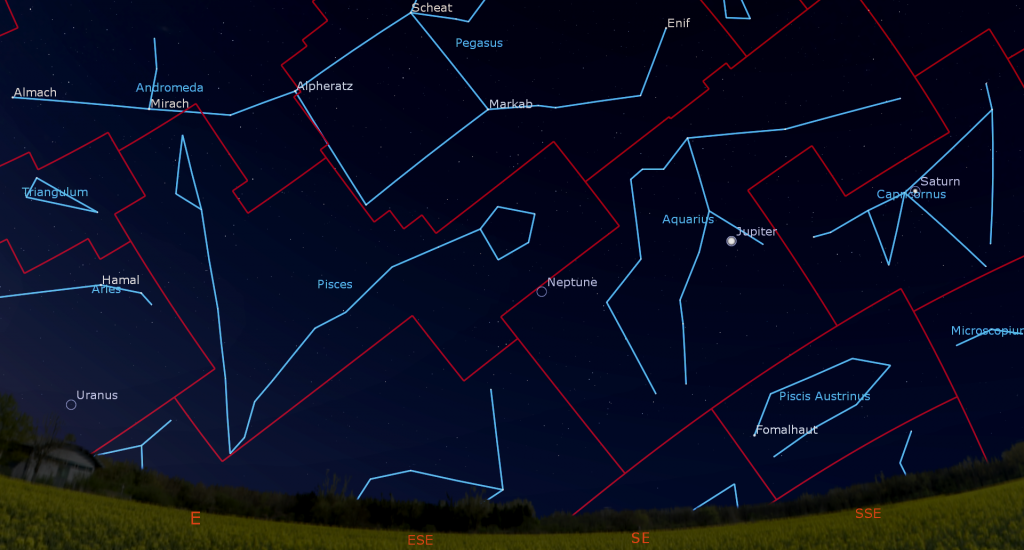
Much brighter (magnitude -2.45) and whiter Jupiter is positioned among the stars of central Aquarius (the Water-Bearer) – about 1.9 fist diameters to Saturn’s lower left (or 19° to the celestial east). With Saturn moving retrograde, the separation between the two planets will increase a little bit every day – until Jupiter begins its own retrograde loop later this month. This week Jupiter will be rising at about 12:45 am local time. It will be easy to see until almost sunrise.
Due to the very low morning ecliptic at this time of year, Jupiter and Saturn don’t climb very high above the horizon, especially for viewers along mid-Northern latitudes. That makes it hard to obtain sharp views of those planets in a telescope. Since the ecliptic is higher for observers at southerly latitudes, both planets will be higher and clearer in telescopes there. If you are willing to take your backyard telescope outside during the wee hours before dawn, the Great Red Spot (or GRS) will be visible crossing Jupiter on Tuesday, Thursday, and Sunday morning.
From time to time, the small round black shadows cast by Jupiter’s four Galilean moons become visible in amateur telescopes as they cross (or transit) the planet’s disk. On Wednesday between 1:30 am and 4:15 am EDT, Io’s small shadow will transit Jupiter. You can see Ganymede’s shadow crossing Jupiter on Saturday morning from 2:45 am EDT until dawn, with the GRS appearing after 4:30 am.
Dim, blue Neptune is following Jupiter across the sky. It rises shortly after 1 am local time, and sits about 2 fist diameters to the left of Jupiter – on the border between Aquarius and Pisces (the Fishes). Later this month, medium-bright Uranus will swing wide enough of the pre-dawn sun to be visible below the bright stars in Aries (the Ram).


The major main belt asteroid designated (3) Juno is still close to its brightest and largest for this year. At magnitude 10.1, the asteroid will be visible in backyard telescopes all night long. Juno is traveling westward through the large, Dr. Who Dalek-shaped constellation of Ophiuchus (the Serpent-Bearer). Tonight (Sunday) it will sit close to a medium-bright star named 30 Ophiuchi. On June Thursday-Friday, (June 17-18) Juno’s motion will carry it through the northern outskirts of the bright globular star cluster designated Messier 10, allowing both objects to appear together in telescopes for several nights!

The minor planet named (4) Vesta, at magnitude 7.2, is within easy reach of binoculars and small telescopes. It’s recently been travelling through the stars of Leo (the Lion). That constellation is found less than halfway up the western sky after dusk. Right now, Vesta is located about two finger widths to the lower left of the bright star Chertan, which marks the lion’s belly or rear foot. Tonight, Sunday, June 13, as a treat for owners of larger telescopes, or who live away from light-polluted skies, Vesta will sit less than a finger’s width to the lower left (or just 0.5° to the celestial southeast) of the Leo Triplet of galaxies! Try to observe them as soon as the sky darkens, when they are higher.
A Comet in Boötes
A faint comet named C/2020 T2 (Palomar) is currently travelling through the constellation of Boötes (the Herdsman), which occupies the southwestern sky in late evening. A few nights ago I observed the comet using my large aperture telescope from a medium-dark sky location outside of Toronto. It was quite faint, but if you live in a dark location, you should be able to see it in your telescope as a very faint, fuzzy patch – possibly greenish in colour.
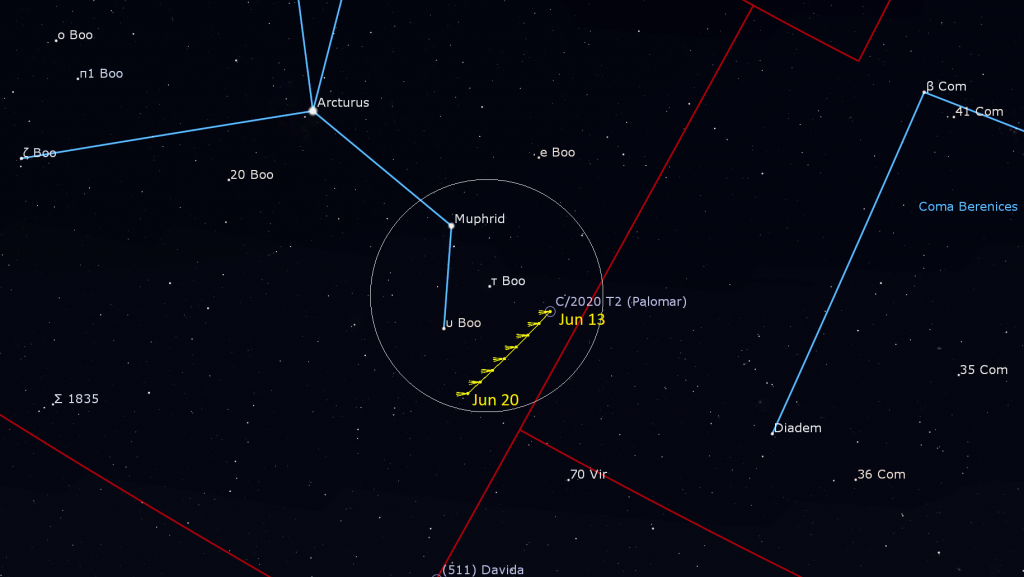
The comet is highest in the sky, and is best seen immediately after the sky fully darkens. This weekend the comet is still near its peak predicted brightness of magnitude 10.5, and is located to the lower right of the very bright star Arcturus. Specifically, it’s several finger widths to the lower right of the medium-bright star Murphrid and two smaller stars.
During this week the comet will travel lower (celestial south) past the Herdsman’s western leg/foot. (Note that the Stellarium and SkySafari programs report a much fainter magnitude than 10.5.)
New Star in Hercules!
A nova has suddenly appeared in the evening sky – near the bright star Deneb al Okab Borealis (or Epsilon Aquilae)’ on the border between the constellations Aquila (the Eagle) and Hercules! At magnitude 6.5, the nova is bright enough to see with binoculars.
A nova (Latin for “new”) is the sudden rapid brightening of a star that occurs when two closely orbiting binary stars transfer gases from one to the other, and the buildup of the extra material causes a runaway nuclear fusion reaction and energy outburst. Usually the nova happens far away, to a star that has not been visible. After reaching maximum brightness a nova will fade, but astronomers will watch it for months, and possibly years, because it could flare up again someday. By measuring the spectrum of the light in the nova, astrophysicists can better understand the process.
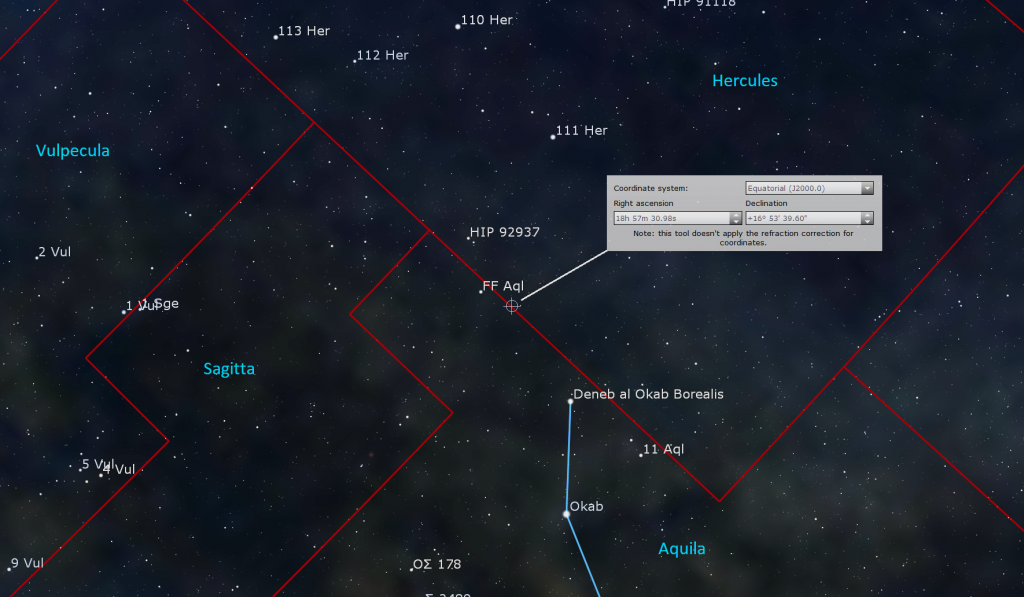
A finder chart for the nova from the American Association of Variable Star Observers (AAVSO) is here.
Public Astro-Themed Events
Every Monday evening, York University’s Allan I. Carswell Observatory runs an online star party – broadcasting views from four telescopes/cameras, answering viewer questions, and taking requests! Details are here. Their in-person Wednesday night viewing has been converted to online via the observatory YouTube channel, where they offer free online viewing through their rooftop telescopes, including their 1-metre telescope! Details are here.
Don’t forget to take advantage of the astronomy-themed YouTube videos posted by RASC Toronto Centre and RASC Canada.
On Monday and Tuesday, June 14 and 15 from 10 am to 2:20 pm EDT, the NativeSkywatchers.com group will present a free online workshop entitled Educator & Community Summer 2021 Workshop: Indigenous STEM & Wellness – Turtle Island Skywatchers! Topics include indigenous relationship to Sky and Earth, Elders’ perspectives, Indigenous education, wellness, community, colonization, youth, leadership, and the Summer night sky! Details and the registration link are here.
On Thursday, June 17 at 12 pm EDT, RASC National will continue their weekly moon-observing series the Moon at Noon featuring Jenna Hinds and guests. Details are here and the registration link is here! Sessions are also live-streamed to YouTube here and can be watched at any time.
My free, family-friendly Insider’s Guide to the Galaxy webcasts with Jenna Hinds of RASC National will return in July with a Summer Planets Spectacular! You can find more details, and the schedule of future sessions, here and here.
Space Station Flyovers
The ISS (or International Space Station) will not be visible over the GTA this week.
Keep looking up, and enjoy the sky when you do. I love questions and requests. Send me some!